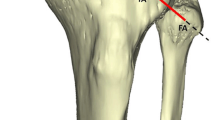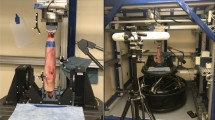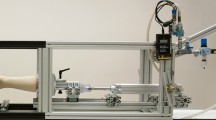Abstract
Purpose
The proximal tibiofibular joint (PTFJ) is a rather unknown articulation. There is little understanding of its anatomy, physiology, and functional role. The objectives of this research are to describe the normal kinematics of the PTFJ and its relation to the ankle and knee movements.
Methods
Fourteen knees of seven adult fresh frozen whole body cadavers were studied. The proximal tibiofibular joint and ligaments were identified, after which we sequentially sectioned the anterior proximal tibiofibular ligament (APTFL), the posterior proximal tibiofibular ligament (PPTFL), and the interosseous syndesmotic membrane. Models with intact and sectioned ligaments were compared, while the unloaded lower limb was manually mobilized in a pre-defined sequence of combined movements of knee, ankle, and proximal tibiofibular joints. The PTFJ spatial displacement was measured by analyzing the length of a distance vector between two 3D coordinate systems settled over the tibia and fibula.
Results
On the unaltered PTFJ, direct grasping of the head of the fibula with the hip in 45° of flexion and the knee in 90° of flexion was found to produce an average displacement of 7 mm. Knee movements caused the greatest spatial displacements, almost ten times the ones produced by ankle flexion/extension. Flexion/extension of the knee caused 1.8 times more displacement than single rotations with the knee flexed to 90°. It was found that the APTFL was an important stabilizer of the PTFJ when this joint is tensioned accommodating the movements of ankle extension and foot eversion. The APTFL was not a significant stabilizer of the PTFJ during direct manipulation of the fibular head when imprinting a manual force with posterior direction. The PPTFL was an important accommodator of ankle flexion, foot inversion and knee flexion. The interosseous syndesmotic membrane also proved to be a significant PTFJ stabilizer in rotational movements of the ankle and knee.
Conclusions
This is the first cadaver study to illustrate the PTFJ normal spatial displacement, thereby contributing to a deeper insight of this joint. The contribution of each ligament for PTFJ stability was described and, based on these findings; a new mechanism of injury was suggested. Surgeons can translate the results of this study into the clinical practice.


Similar content being viewed by others
Abbreviations
- PTFJ:
-
Proximal tibiofibular joint
- Distal TFJ:
-
Distal tibiofibular joint
- APTFL:
-
Anterior proximal tibiofibular ligament
- PPTFL:
-
Posterior proximal tibiofibular ligament
- IOSM:
-
Interosseous syndesmotic membrane
- ROM:
-
Range of motion
References
Anavian J, Marchetti DC, Moatshe G, Slette EL, Chahla J, Brady AW, Civitarese DM, LaPrade RF (2018) The forgotten joint: quantifying the anatomy of the proximal tibiofibular joint. Knee Surg Sports Traumatol Arthrosc 26:1096–1103
Barnett H, Napier JR (1952) The axis of rotation at the ankle joint in man; its influence upon the form of the talus and the mobility of the fibula. J Anat 86:1–9
Bozkurt M, Tonuk E, Elhan A, Tekdemir I, Doral MN (2008) Axial rotation and mediolateral translation of the fibula during passive plantarflexion. Foot Ankle Int 29:502–507
Burkhart TA, Asa B, Payne MWC, Johnson M, Dunning CE, Wilson TD (2015) Anatomy of the proximal tibiofibular joint and interosseous membrane, and their contributions to joint kinematics in below-knee amputations. J Anat 226:143–149
Cazeneuve JF, Bracq H, Meeseman M (1997) Weinert and Giachino ligament arthroplasty for the surgical treatment of chronic superior tibiofibular joint instability. Knee Surg Sports Traumatol Arthrosc 5:36–37
Eichenblat M, Nathan H (1983) The proximal tibio fibular joint. An anatomical study with clinical and pathological considerations. Int Orthop 7:31–39
Espregueira-Mendes JD, Vieira Da Silva M (2006) Anatomy of the proximal tibiofibular joint. Knee Surg Sports Traumatol Arthrosc 14:241–249
Horst PK, LaPrade RF (2010) Anatomic reconstruction of chronic symptomatic anterolateral proximal tibiofibular joint instability. Knee Surg Sports Traumatol Arthrosc 18:1452–1455
Jabara M, Bradley J, Merrick M (2014) Is stability of the proximal tibiofibular joint important in the multiligament-injured knee? Clin Orthop Relat Res 472:2691–2697
Lambert KL (1971) The weight-bearing function of the fibula. A strain gauge study. J Bone Jt Surg Am 53:507–513
Marchetti DC, Chahla J, Moatshe G, Slette EL, LaPrade RF (2018) Quantitative radiographic assessment of the anatomic attachment sites of the anterior and posterior complexes of the proximal tibiofibular joint. Knee Surg Sports Traumatol Arthrosc 26:1104–1109
Marchetti DC, Moatshe G, Phelps BM, Dahl KD, Ferrari MB, Chahla J, Turnbull TL, LaPrade RF (2017) The proximal tibiofibular joint: a biomechanical analysis of the anterior and posterior ligamentous complexes. Am J Sports Med 45:1888–1892
Minns RJ, Hunter JA (1976) The mechanical and structural characteristics of the tibio-fibular interosseous membrane. Acta Orthop Scand 47:236–240
Ogden JA (1974) Subluxation and dislocation of the proximal tibiofibular joint. J Bone Jt Surg Am 56:145–154
Ogden JA (1974) The anatomy and function of the proximal tibiofibular joint. Clin Orthop Relat Res 101:186–191
Ogden JA (1974) Subluxation of the proximal tibiofibular joint. Clin Orthop Relat Res 101:192–197
Semonian RH, Denlinger PM, Duggan RJ (1995) Proximal tibiofibular subluxation relationship to lateral knee pain: a review of proximal tibiofibular joint pathologies. J Orthop Sports Phys Ther 21:248–257
Sijbrandij S (1978) Instability of the proximal tibio-fibular joint. Acta Orthop Scand 49:621–626
Soavi R, Girolami M, Loreti I, Bragonzoni L, Monti C, Visani A, Marcacci M (2000) The mobility of the proximal tibio-fibular joint. A roentgen stereophotogrammetric analysis on six cadaver specimens. Foot Ankle Int 21:336–342
Wu G, Siegler S, Allard P, Kirtley C, Leardini A, Rosenbaum D, Whittle M, D’Lima DD, Cristofolini L, Witte H, Schmid O, Stokes I (2002) ISB recommendation on definitions of joint coordinate system of various joints for the reporting of human joint motion—part I: ankle, hip, and spine. Int Soc Biomech J Biomech 35:543–548
Acknowledgements
We thank Professor João Goyri O’Neil and the Department of Anatomy of Medical College, Universidade Nova de Lisboa for provision of the specimens and assistance with laboratory setup. We thank Escola Superior de Saúde, Instituto Politécnico de Setúbal for providing the hardware and software for the 3D kinematic analysis. We thank Physiotherapist Mario Valerio and PhD Candidate Rodrigo Brandão Martins for providing support during data collection and analysis.
Funding
No funding has been received for this study.
Author information
Authors and Affiliations
Contributions
TAS, PP, and FGP conceived the study, participated in its design and coordination, carried out the experimental study, participated in the sequence alignment, and drafted the manuscript. RM participated in the study design and data analysis. All authors read and approved the final manuscript.
Corresponding author
Ethics declarations
Conflict of interest
The authors declare that they have no competing interests with respect to the research, authorship and publication of this article. The authors received no financial support for the research, authorship and publication of this article.
Ethical approval
This article does not contain any studies with living human participants performed by any of the authors.
Informed consent
For this type of study formal consent is not required.
Rights and permissions
About this article
Cite this article
Alves-da-Silva, T., Guerra-Pinto, F., Matias, R. et al. Kinematics of the proximal tibiofibular joint is influenced by ligament integrity, knee and ankle mobility: an exploratory cadaver study. Knee Surg Sports Traumatol Arthrosc 27, 405–411 (2019). https://doi.org/10.1007/s00167-018-5070-8
Received:
Accepted:
Published:
Issue Date:
DOI: https://doi.org/10.1007/s00167-018-5070-8




